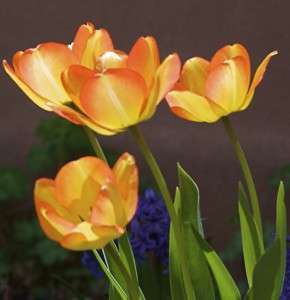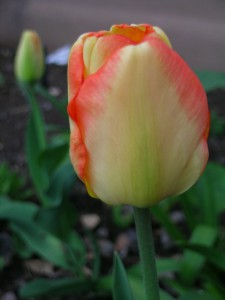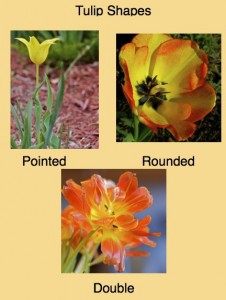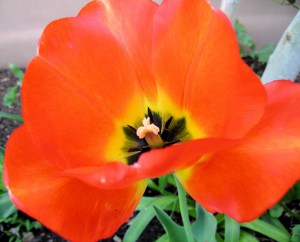Scientific name: Tulipa species
Family: Liliaceae (Lily)
Common name: Tulip species
Photos and text by Janice Tucker
The Tulip – a much-anticipated harbinger of spring – is one of the most fascinating flowers in the world. There is nothing ordinary about this plant and the following paragraphs do not even begin to scratch the surface of its influence on history, its beauty and its charm. On February 21, the Santa Fe Botanical Garden’s “Desire” lecture of its 2012 “Passionate Vision: Pleasure, Desire, Mystery and Power” series will feature “Tulip – The Flower that Drove Men Mad”. Presenter Bonnie Joseph will draw you into the rich history and magic of this enchanting plant.
The tulip often invokes thoughts of The Netherlands, and indeed the Dutch deserve credit for much of its global popularity and interesting history. However, it is not indigenous to that country. The tulip is native to a vast area that includes the arid climates of Africa, Asia and Europe. The commercialization of the tulip began in the Ottoman Empire and is the official flower of Iran (Persia). Richard S. Fay, a wealthy landowner, is credited with growing the first tulips in the United States on his estate in Lynn, Massachusetts from 1847 to 1865.

Photo: Janice Tucker
In the 16th century, tulips from the Ottoman Empire began showing up in Western Europe. Historians differ upon whom to credit for being the first individual to import them. Carolus Clusius was among the first to bring tulips to The Netherlands in 1593, where he planted them in the newly established Hortus Botanicus at Leiden University.
The Dutch loved the tulip! In fact, they were wild about it. Between 1633 and 1637, the tulips became so highly esteemed in The Netherlands that one single bulb of a rare type of tulip, in particular the Semper augustus, was worth more than 10 times the annual income of most families. Tulip bulbs were traded as futures and soon created a trading frenzy known as “tulipmania”, now recognized as one of the earliest speculative economic bubbles. The bubble ultimately burst, bringing economic ruin to many. “Tulipmania” is a phrase used in today’s financial terminology when referring to frenzied speculative trading.
Among the tulips commanding the highest prices during tulipmania were those varieties that produced unusual, beautiful, variegated flowers. The multicolored petals of these coveted tulips were caused by the Tulip Breaking Virus (TBV) carried by the green peach aphid, a pest commonly found in 17th century European gardens. The virus weakened the bulb, making the plant susceptible to early die out and could spread to nearby tulip beds. Unfortunately for the investors, the cause for these unusual tulip flowers had not yet been discovered during the trading frenzy. TBV has since been largely eradicated and today’s multicolored varieties are a result of controlled crossbreeding by reputable horticulturists.

Photo: Janice Tucker
The name tulip, which first appeared in the English language as tulipa or tulipant, has quite a history of evolution through French, Modern Latin, Ottoman Turkish and finally traced to its Persian origin of dulband, which means “round”, turban-like” or “gauze”. The tulip, in its rounded petal form before fully opening, is likened to the shape of the gauzy turbans worn by the natives of that region. The scientific name for the genus is Tulipa, which has over 110 species and thousands of hybrids and cultivars.
A member of the Lily (Liliaceae) plant family, the tulip is a perennial, bulbous plant that blooms in a large variety of colors from early to mid-spring, depending on the climate. The height of the tulip depends on the species and can range from 4 to 28 inches. The stems, also known as scapes, emerge from the bulb, and generally produce one flower per stem. The flowers are rounded or pointed with 6 tepals (3 petals and 3 sepals). Each flower has 6 distinct stamens with filaments shorter than the tepals. Each stigma of the flower has 3 lobes and a superior, 3-chambered ovary. The average tulip has 2 to 6 blue-green, alternate leaves. The elliptical-shaped fruit resembles a seed-filled capsule with a tough, leathery cover. A caveat to the preceding description: There are often departures from the norm. Some tulip species produce more than one flower per stem and the flowers of cultivars come in various shapes, including double blooms.

Tulip Shapes
Late summer and fall are the recommended times to plant tulips in well-drained soils at a depth of 4 to 8 inches, depending on the species. In order to bloom, the tulip bulb needs a period of cool dormancy (vernalization). Tulips are ideal for our Santa Fe climate of cool winters and warm, dry summers and often naturalize in our local gardens. In more temperate climates, they will rot if left in the ground. Dividing tulips after a few years will help prevent bulb die-out. In order for the bulb to store sufficient nutrients that allow it to bloom the following year, the foliage should remain on the plant until it begins to die back naturally. While it is tempting to plant only the gorgeous hybrids and cultivars, species tulips are among the hardiest bulbs. They are beautiful, re-seed and produce many bulb offsets that do not die out as quickly as their cultivated descendants.
Propagation is from bulb offsets or seed. Tulips propagated from seed are usually more genetically varied. Seeds are often used to propagate species or to create new hybrids. Tulips propagated by seeds take several years before flowering while tulips from bulb offset propagation will bloom after a year or two. It is important for those growing or propagating tulips to remember that they can cross-pollinate, especially species tulips.
Tulip stems will continue to grow after they have been cut and placed in water. For those who wish their tulips to remain upright in an arrangement, the stems will need to be kept trimmed. But many prefer to let the stems grow, allowing the tulips to drape over a vase in a charming, free form style. Most tulips have a black center that is said to represent a lover’s heart, darkened by the heat of passion. Fresh tulip petals are edible (but not the bulb) and are sometimes used in salads or on tea sandwiches.

Photo: Janice Tucker
By speaking in the colorful language of tulips, it is possible to convey many heart-felt sentiments. Yellow tulips symbolize cheerful thoughts. White means worthiness, heaven, purity or forgiveness. Purple signifies royalty and red tulips claim perfect love. Orange indicates passion, cream means “I will love you forever” and variegated petals mean “You have beautiful eyes”. A tulip bouquet represents elegance and grace. Since tulips are among the first flowers of spring, they are a symbol for eternal life.
If you decide to declare your feelings by sending flowers this Valentine’s Day or for any occasion, choosing tulips will insure that no matter what, you cannot possibly say the wrong thing.


